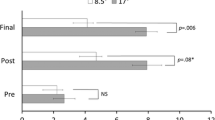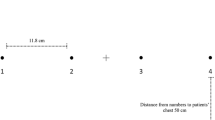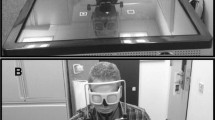Abstract
Prism adaptation (PA) is a promising rehabilitation technique for visuo-spatial neglect, an attention disorder that is characterized by spatial attention deficits (i.e., deficits in orienting). PA involves visuo-motor adaptation to rightward shifting prism goggles. Following goggle removal, this adaptation results in leftward shifts in visuo-motor aiming and amelioration of spatial neglect. Even though some studies clearly support the beneficial effects of PA for spatial neglect, not all studies find benefits, thus it remains unclear how PA effects could be improved. Taking advantage of the known interactions between orienting and alerting reported in the attention literature (i.e., alerting enhances orienting function; e.g., Ishigami and Klein in J Individ Differ 30:220–237. doi:10.1027/1614-0001.30.4.220, 2009, in J Neurosci Methods 190:117–28. doi:10.1016/j.jneumeth.2010.04.019, 2010; Robertson et al. in Nature 395:169–72. doi:10.1038/25993, 1998), we examined the effects of alerting tones on PA with healthy young and older adults. We found that the effects of alerting on PA with young adults were negative, while there was a positive effect with older adults, specifically on a visuo-motor outcome task. Thus, enhancement of PA effects by alerting may be age specific and task specific. Therefore, we can conclude that while the impact of alerting tones is not always positive, further research in patients with neglect may be warranted.



Similar content being viewed by others
Notes
There were 144 trials for participants we tested earlier (n = 11). Data from the first two blocks were analyzed to be consistent with the participants we tested later.
References
Appelros P, Karlsson GM, Seiger A, Nydevik I (2002) Neglect and anosognosia after first-ever stroke: incidence and relationship to disability. J Rehabil Med 34:3215–3220
Bartolomeo P, Chokron S (2002) Orienting of attention in left unilateral neglect. Neurosci Biobehav Rev 26:217–234
Bartolomeo P, Thiebaut de Schotten M, Chica AB (2012) Brain networks of visuospatial attention and their disruption in visual neglect. Front Hum Neurosci 6:110. doi:10.3389/fnhum.2012.00110
Berberovic N, Pisella L, Morris AP, Mattingley JB (2004) Prismatic adaptation reduces biased temporal order judgements in spatial neglect. Cogn Neurosci Neuropsychol 15:1199–1204. doi:10.1097/01.wnr.0000125780.50515.7a
Bultitude JH, Rafal RD, List A (2009) Prism adaptation reverses the local processing bias in patients with right temporo-parietal junction lesions. Brain 132:1669–1677. doi:10.1093/brain/awp096
Butler BC, Eskes GA, Klein RM (2010) Measuring the components of attention. Can J Ex Psychol 64:323–328
Callejas A, Lupiàñez J, Funes MJ, Tudela P (2005) Modulations among the alerting, orienting and executive control networks. Exp Brain Res 167:27–37. doi:10.1007/s00221-005-2365-z
Corbetta M, Shulman GL (2011) Spatial neglect and attention networks. Annu Rev Neurosci 34:569–599. doi:10.1146/annurev-neuro-061010-113731
Corbetta M, Kincade MJ, Lewis C, Snyder AZ, Sapir A (2005) Neural basis and recovery of spatial attention deficits in spatial neglect. Nat Neurosci 8:1603–1610
Coull JT, Frith CD, Frackowiak RS, Grasby PM (1996) A fronto-parietal network for rapid visual information processing: a PET study of sustained attention and working memory. Neuropsychologia 34:1085–1095
Coull JT, Frith CD, Büchel C, Nobre AC (2000) Orienting attention in time: behavioural and neuroanatomical distinction between exogenous and endogenous shifts. Neuropsychologia 38:808–819
Danckert J, Ferber S (2006) Revisiting unilateral neglect. Neuropsychologia 44:987–1006
DeGutis JM, Van Vleet TM (2010) Tonic and phasic alertness training: a novel behavioral therapy to improve spatial and non-spatial attention in patients with hemispatial neglect. Front Hum Neurosci 4:1–17. doi:10.3389/fnhum.2010.00060
Fan J, McCandliss BD, Sommer T, Raz A, Posner M (2002) Testing the efficiency and independence of attentional networks. J Cogn Neurosci 14:340–347
Fan J, McCandliss BD, Fossella J, Flombaum JI, Posner MI (2005) The activation of attentional networks. Neuroimage 26:471–479. doi:10.1016/j.neuroimage.2005.02.004
Halligan PW, Marshall JC (1998) Visuospatial neglect: the ultimate deconstruction? Brain Cogn 37:419–438. doi:10.1006/brcg.1998.1006
Heilman KM (1979) Neglect and related disorders. In: Heilman KM, Valenstein E (eds) Clinical neuropsychology. Oxford University Press, New York, pp 268–307
Hjaltason H, Tegnér R, Tham K, Levander M, Ericson K (1996) Sustained attention and awareness of disability in chronic neglect. Neuropsychologia 34:1229–1233
Ishigami Y, Klein RM (2009) Are individual differences in absentmindedness correlated with individual differences in attention? J Individ Differ 30:220–237. doi:10.1027/1614-0001.30.4.220
Ishigami Y, Klein RM (2010) Repeated measurement of the components of attention using two versions of the Attention Network Test (ANT): stability, isolability, robustness, and reliability. J Neurosci Methods 190:117–128. doi:10.1016/j.jneumeth.2010.04.019
Ishigami Y, Klein RM (2011) Repeated measurement of the components of attention of older adults using the two versions of the attention network test: stability, isolability, robustness, and reliability. Front Aging Neurosci 3:17. doi:10.3389/fnagi.2011.00017
Ishigami Y, Lawrence MA, Klein RM, Eskes G (2012) Attention networks and their interactions in healthy aging. Paper accepted for Our Future is Aging: current research on knowledge, practice and policy, Halifax, NS, Canada (November 21–23, 2012)
Karnath HO, Fruhmann Berger M, Küker W, Rorden C (2004) The anatomy of spatial neglect based on voxelwise statistical analysis: a study of 140 patients. Cereb Cortex 14:1164–1172. doi:10.1093/cercor/bhh076
Luauté J, Halligan P, Rode G, Jacquin-Courtois S, Boisson D (2006a) Prism adaptation first among equals in alleviating left neglect: a review. Restor Neurol Neurosci 24:409–418
Luauté J, Michel C, Rode G, Pisella L, Jacquin-Courtois S, Costes N, Cotton F, le Bars D, Boisson D, Halligan P, Rossetti Y (2006b) Functional anatomy of the therapeutic effects of prism adaptation on left neglect. Neurology 66:1859–1867. doi:10.1212/01.wnl.0000219614.33171.01
Mattingley JB, Husain M, Rorden C, Kennard C, Driver J (1998) Motor role of human inferior parietal lobe revealed in unilateral neglect patients. Nature 392:179–182
Morris AP, Kritikos A, Berberovic N, Pisella L, Chambers CD, Mattingley JB (2004) Special section prism adaptation and spatial attention: a study of visual search in normal’s and patients with unilateral neglect. Cortex 40:703–721
Morton SM, Bastian AJ (2004) Prism adaptation during walking generalizes to reaching and requires the cerebellum. J Neurophysiol 92:2497–2509. doi:10.1152/jn.00129.2004
Paolucci S, Antonucci G, Grasso MG, Pizzamiglio L (2001) The role of unilateral spatial neglect in rehabilitation of right brain–damaged ischemic stroke patients: a matched comparison. Arch Phys Med Rehabil 82:743–749. doi:10.1053/apmr.2001.23191
Pisella L, Rode G, Farne A, Tilikete C, Rossetti Y (2006) Prism adaptation in the rehabilitation of patients with visuo-spatial cognitive disorders. Curr Opin Neurol 19:1–10
Posner MI (2008) Measuring alertness. Ann N Y Acad Sci 1129:193–199. doi:10.1196/annals.1417.011
Posner MI, Peterson SE (1990) The attention system of the human brain. Annu Rev Neurosci 13:25–42. doi:10.1146/annurev.ne.13.030190.000325
Posner M, Walker A, Friedrich J, Rafal R (1984) Effects of parietal injury on covert orienting of attention. J Neurosci 4:1863–1874
Posner MI, Inhoff AW, Friedrich FJ, Cohen A (1987) Isolating attentional systems: a cognitive-anatomical analysis. Psychobiol 15:107–121
Redding GM, Wallace B (1988) Components of prism adaptation in terminal and concurrent exposure: organization of the eye-hand coordination loop. Percept Psychophys 44:59–68
Redding GM, Wallace B (2006) Prism adaptation and unilateral neglect: review and analysis. Neuropsychologia 44:1–20
Redding GM, Rossetti Y, Wallace B (2005) Applications of prism adaptation: a tutorial in theory and method. Neurosci Biobehav Rev 29:431–444
Robertson IH, Tegnér R, Tham K, Lo A, Nimmo-Smith I (1995) Sustained attention training for unilateral neglect: theoretical and rehabilitation implications. J Clin Exp Neuropsychol 17:416–430. doi:10.1080/01688639508405133
Robertson IH, Manly T, Beschin N, Daini R, Haeske-Dewick H, Hömberg V, Jehkonen M, Pizzamiglio G, Shiel A, Weber E (1997) Auditory sustained attention is a marker of unilateral spatial neglect. Neuropsychologia 35:1527–1532
Robertson IH, Mattingley JB, Rorden C, Driver J (1998) Phasic alerting of neglect patients overcomes their spatial deficit in visual awareness. Nature 395:169–172. doi:10.1038/25993
Rode G, Klos T, Courtois-Jacquin S, Rossetti Y, Pisella L (2006) Neglect and prism adaptation: a new therapeutic tool for spatial cognition disorders. Restor Neurol Neurosci 24:347–356
Rossetti Y, Rode G, Pisella L, Farné A, Li L, Boisson D, Perenin MT (1998) Prism adaptation to a rightward optical deviation rehabilitates left hemispatial neglect. Nature 395:166–169. doi:10.1038/25988
Rousseaux M, Bernati T, Saj A, Kozlowski O (2006) Ineffectiveness of prism adaptation on spatial neglect signs. Stroke 37:542–543. doi:10.1161/01.STR.0000198877.09270.e8
Siéroff E, Decaix C, Chokron S, Bartolomeo P (2007) Impaired orienting of attention in left unilateral neglect: a componential analysis. Neuropsychology 21:94–113. doi:10.1037/0894-4105.21.1.94
Striemer CL, Danckert JA (2010) Through a prism darkly: re-evaluating prisms and neglect. Trends Cogn Sci 14:308–316. doi:10.1016/j.tics.2010.04.001
Sturm W, Willmes K (2001) On the functional neuroanatomy of intrinsic and phasic alertness. Neuroimage 14:S76–S84. doi:10.1006/nimg.2001.0839
Sturm W, Longoni F, Weis S, Specht K, Herzog H, Vohn R, Thimm M, Willmes K (2004) Functional reorganisation in patients with right hemisphere stroke after training of alertness: a longitudinal PET and fMRI study in eight cases. Neuropsychologia 42:434–450. doi:10.1016/j.neuropsychologia.2003.09.001
Sturm W, Thimm M, Küst J, Karbe H, Fink GR (2006) Alertness-training in neglect: behavioral and imaging results. Restor Neurol Neurosci 24:371–384
Thimm M, Fink GR, Küst J, Karbe H, Sturm W (2006) Impact of alertness training on spatial neglect: a behavioural and fMRI study. Neuropsychologia 44:1230–1246. doi:10.1016/j.neuropsychologia.2005.09.008
Vallar G, Perani D (1986) The anatomy of unilateral neglect after right-hemisphere stroke lesions: a clinical/CT-scan correlation study in man. Neuropsychologia 24:609–622. doi:10.1016/0028-3932(86)90001-1
Van Rossum G, Drake FL (2001) Python Reference Manual. PythonLabs, Virginia, USA. http://www.python.org
Van Vleet TM, Robertson LC (2006) Cross-modal interactions in time and space: auditory influence on visual attention in hemispatial neglect. J Cogn Neurosci 18:1368–1379. doi:10.1162/jocn.2006.18.8.1368
Vossel S, Weiss PH, Eschenbeck P, Fink GR (2012) Anosognosia, neglect, extinction and lesion site predict impairment of daily living after right-hemispheric stroke. Cortex 49:1782–1789. doi:10.1016/j.cortex.2012.12.011
Wilson FC, Manly T (2003) Sustained attention training and errorless learning facilitates self-care functioning in chronic ipsilesional neglect following severe traumatic brain injury. Neuropsychol Rehabil 13:537–548. doi:10.1080/09602010343000200
Acknowledgments
This research was supported by a Canadian Institutes of Health Research (CIHR) operating grant (to Dr. Gail Eskes) and by the Atlantic Canada Opportunities Agency (ACOA, through the Atlantic Innovation Fund program to Dr. Gail Eskes). Franziska Kintzel was supported by the Trans-Atlantic Neuroscience Teaching Network (TANTEN), in cooperation with Maastricht University (The Netherlands) and Dalhousie University. Franziska Kintzel thanks Dr. Eric Vuurman (Maastricht University) for the support and supervision during the conduct of the project. Dr. Yoko Ishigami was supported by a postdoctoral funding from ACOA. We thank Joshua Salmon for his valuable assistance in programming of the tasks.
Author information
Authors and Affiliations
Corresponding author
Rights and permissions
About this article
Cite this article
Kintzel, F., Ishigami, Y. & Eskes, G.A. Ready, set, point: The effects of alertness on prism adaptation in healthy adults. Exp Brain Res 233, 1441–1454 (2015). https://doi.org/10.1007/s00221-015-4218-8
Received:
Accepted:
Published:
Issue Date:
DOI: https://doi.org/10.1007/s00221-015-4218-8




